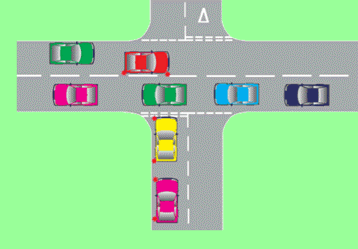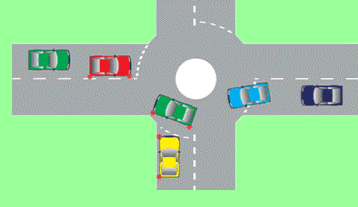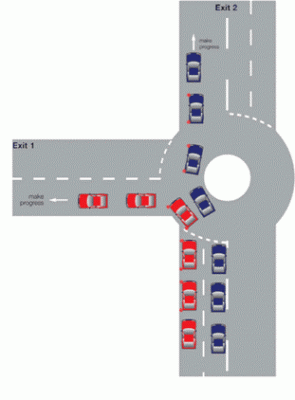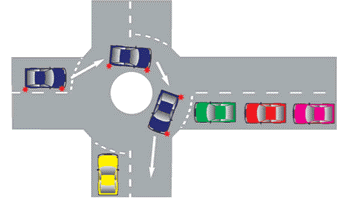All About Roundabouts
Roundabouts are designed to keep the traffic flowing. Traffic should only flow in a clockwise direction around the island in the centre of the roundabout. This circular road is a one-way street and may be made up of one or more lanes. Mini roundabouts are much smaller but have the same purpose to keep the traffic flowing. Traffic entering the roundabout must give way to traffic already on the roundabout approaching from the right.
Why Roundabouts Exist
This diagram shows the problem of having two busy roads meeting without the presence of a roundabout. The red car is finding it difficult to turn into the road on its right. (This may also lead to holding up traffic behind).
Cars emerging on to the main road will also find it difficult to make progress when the road is busy.
This diagram shows the benefit of having a roundabout.
Now the roundabout rules apply people only need to give way to the right allowing traffic to flow much more freely. The red car that was finding it difficult before can now go around the roundabout to turn right. The yellow car will now find it easier to emerge as the vehicles on the right will be blocked by traffic crossing their path.
Rules that apply
- Follow the M-S-M routine on approach ensuring you position in the appropriate lane in good time
- Give way to traffic that will cross your path from your right. (You must not cause traffic on your right to change speed or direction)
- Keep in correct lane on the roundabout
- Apply the M-S-M routine on your exit
The following diagrams show various roundabouts which will help explain how to deal with them and which lane to take.
Lane discipline
On a standard roundabout:
Turning left (red car)
Use the left lane as it is your first exit, signal left on approach.
Turning right (Exit 3 on diagram)
Signal right on approach and use the right hand lane and stay on the inside of the roundabout until you pass the last exit that is just before your turn (Exit 2 on diagram). Check mirrors and signal left to confirm your intentions to exit the roundabout.
Following the road ahead
On a standard roundabout (as blue car on diagram) you should use the left lane and stay on the outside of the roundabout. No signal will be required on approach as it is the second exit you require, check mirrors and apply a left signal as you pass Exit 1.
Following the road ahead
If the layout was as below:
Approach on the right and stay on the inside of the roundabout until you pass the first exit, then apply the M-S-M routine for leaving the roundabout (giving a left signal).
Look for lane markings
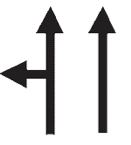 If you are following the road ahead on a main route (eg dual carriageway) you can often go ahead in either lane. If you approach on the left then you should stay to the left in new road, if you take the right hand lane on approach stay on the inside of the roundabout and exit in the right hand lane in new road.
If you are following the road ahead on a main route (eg dual carriageway) you can often go ahead in either lane. If you approach on the left then you should stay to the left in new road, if you take the right hand lane on approach stay on the inside of the roundabout and exit in the right hand lane in new road.
Following the road ahead
If the layout was as below:
Approach on the left and stay on the outside of the roundabout. As the exit you are taking (blue car) is your first then you can indicate left on approach to confirm your intentions.
Turning Right
If you are turning right (yellow car) use the right hand lane and stay on the inside of the roundabout until you pass the first exit. Then check your mirrors and apply a left signal.
Giving Way
Although traffic can come all the way around the roundabout from Exit 1 (ahead) you will mainly have traffic to give way to only coming out of one exit – Exit 2 that intends to turn right therefore the majority of the time they will need to approach in their right hand lane, the traffic approaching on their left should be turning left and if so you will not need to give way.
 Looking for Lane Markings
Looking for Lane Markings
If the lane markings show that you can use either lane following the road ahead: If you approach on the left then you should stay to the left in new road, if you take the right hand lane on approach stay on the inside of the roundabout and exit in the right hand lane in new road.
Lane Discipline
On this roundabout the road markings show that the left hand lane should only be used for turning left. This will normally be where the left exit is more of a main route (i.e. city centre route or leading to a motorway).
Following the road ahead (where the left-hand lane is for turning left only)
As the markings show – you will need to use the right hand lane to follow the road ahead. Keep to the inside of the roundabout until passing the first exit. Be extra careful until passing the first exit and as you exit in case other vehicles have followed the road ahead in the left lane, which is the case on most roundabouts.
Following the road ahead on a dual carriageway
Lane discipline
Here you will be able to follow the road ahead in either lane.
If you approach in the left hand lane stay on the outside of the roundabout and keep to the left on your exit.
Key Considerations
- Ensure you approach in the correct lane in good time
- Most dual carriageways are high speed roads – try to keep appropriate speed
- Be mindful of traffic to your sides especially larger vehicles which may not stick to their lane
Multi lanes
If you have three or more lanes – look for road markings for most appropriate lane to use.
Roundabouts – Making Progress
Take opportunities to make progress when traffic to your right will be blocked – here the yellow car can emerge as the traffic opposite, which is going ahead at the roundabout, is blocking the traffic to the right.
On this example the yellow car can take the opportunity to make progress when the blue car turning right blocks the traffic.
When the roundabout is big enough to allow enough room – if you are turning left (yellow car) and you can see traffic intends to turn right then you will not cause them to change speed or direction as you will be on the outside of the roundabout and they would be on the inside.
When vehicles are coming around the roundabout and you have not seen which junction they emerged from, you will not know which exit they are taking so will need to give way to them
Mini Roundabouts

(Because junctions are closer it is easy to give way to traffic you have priority over). Follow the M-S-M routine on approach.
Sometimes mini roundabouts are hard to identify early:- look out for the sign.
Example for taking a right turn
Priority
Here the yellow car has priority as traffic must give way to their right.
Key Points
- When turning right ensure your signal is maintained (re-apply if it cancels) otherwise traffic may not give way to you.
- Drive around the centre circle (large vehicles may have no choice but to drive over it).
- When following the M-S-M routine on exit your left signal showing your intentions to leave roundabout will not always be important – apply if you have time. When turning right your steering will take priority.

